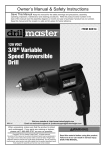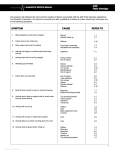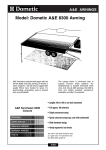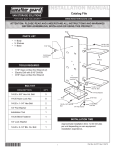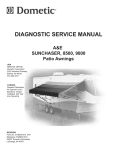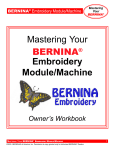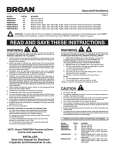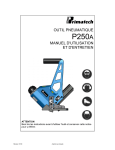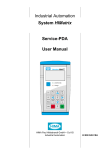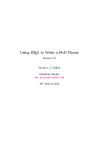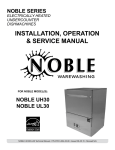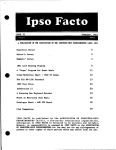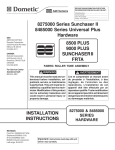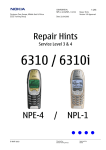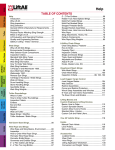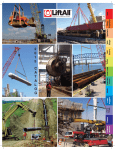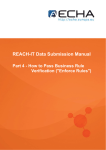Download Model: Dometic A&E 8500 Awning
Transcript
A&E AWNINGS Model: Dometic A&E 8500 Awning Australia’s Favorite Awning For great looks and long life, more RVers choose the A&E Imperial 8500 than any other brand or model. Its heavy-duty premium vinyl canopy has the rich vibrant Horizon stripe color pattern on top and bottom with color-matched weathershield. The dependable, easy-operating A&E Universal Hardware is available in straight or curved models to fit virtually any vehicle. • Large torsion assembly for dependability, long life and smooth, effortless operation • Patented anti-slack rafter pivot keeps fabric tinder tension when moving arms between pivot and carport positions • A&E's heaviest polyester reinforced vinyl fabric side hems for added durability • Exclusive Permaloop pull strap makes it easier to open awning • Lengths 8ft to 25ft in one foot increments • Full approx. 8ft extension A&E 8500 Colours • 12 Months Warranty Australia wide. • Easiest-to-use ergonomic lock knobs BURGUNDY ROSE • A&E Universal hardware CODE DZ ALPINE GREEN/PERIWINKLE CODE DY FAWN/CINNAMON CODE EA The color in this chart should be used as a guide only. For exact fabric color, see A&E's fabric sample kit. GULF BLUE CODE DX iNDEX RECORD THIS INFORMATION FOR FUTURE REFERENCE BEFORE INSTALLING THE UNIT: Model Number Serial Number Date Purchased Place of Purchase 838000D, 838100D, 839000D, 840000, 8410000, 8471000, 8472000, 8474000, 8475000, 8480000, 8481000, 8481003, 8490000, 8491000, Series Universal Hardware for use with USA The Dometic Corp. 8500, 9000 Fabric Roller Tube Assembly . Dometic PTY Clayton Vic This manual must be read and understood before installation, adjustment, service, or maintenance is performed. This unit must be installed by a qualified service technician. Modification of this product can be extremely hazardous and could result in personal injury or property damage. Lire et comprendre ce manuel avant de procéder à l'installation, à des réglages, de l'entretien ou des réparations. L'installation de cet appareil doit être effectuée par un réparateur qualifié. Toute modification de cet appareil peut être extrêmement dangereuse et entraîner des blessures ou dommages matériels. 838000D, 838100D, 839000D, 840000, 8410000, 8471000, 8472000, 8474000, 8475000, 8480000, 8481000, 8481003, 8490000, 8491000, SERIES UNIVERSAL HARDWARE INSTALLATION INSTRUCTIONS REVISION Form No. 3103837.070 6/02 (Replaces 3103837.062) (French 3108060.017) ©2002 Dometic Corporation LaGrange, IN 46761 INDEX 1 SAFETY INSTRUCTIONS This manual has safety information and instructions to help users eliminate or reduce the risk of accidents and injuries. RECOGNIZE SAFETY INFORMATION ! This is the safety-alert symbol. When you see this symbol in this manual, be alert to the potential for personal injury. Follow recommended precautions and safe operating instructions. UNDERSTAND SIGNAL WORDS A signal word , WARNING OR CAUTION is used with the safety-alert symbol. They give the level of risk for potential injury. WARNING: means if the safety information is not followed someone could be injured or killed and/or damage to equipment could occur. CAUTION: means if the safety information is not followed someone might be injured and/or damage to equipment might occur. Read and follow all safety information and instructions. Dometic A&E 8500, 9000 INSTALLATION COVERED BY PATENT 4,524,791; 5,351,736; 5,566,918; 5,383,346; D353,473, others pending Application The A&E awning with "Universal Hardware" is designed and intended for use on motorhomes, mini-motorhomes, 5th wheels and travel trailers with straight or curved sides. For curved sides, please see the separate Hardware List in the Dealer Service Manual for the appropriate model. 2. Carefully lay the fabric roller tube assembly on "V" troughs or other well protected surface to prevent fabric damage. Secure arm assemblies to the respective top castings using 1/4–20 x 1/2" hex. hd. machine screws and 1/4" lock washers. (FIG. 2) CAUTION: DO NOT REMOVE the cotter pins at this time and DO NOT attempt to rotate the Safe-T-LockTM Lever until installation is complete. (Lever is pre-set in the roll-up position.) (FIG. 2) FIG. 4B TOP SLAT (9000 Awnings) IMPORTANT: Read and understand ALL of the following steps before beginning installation. The Dometic Corporation reserves the right to modify appearances and specifications without notice. FIG. 3 BEFORE Position Wheel Directly over edge of Door AFTER FIG. 1B SCREEN ENTRY DOOR A door screen edge guard must be installed on the outside of the screen door in the extreme upper corner opposite the door hinges. (FIG. 1B) When the entry or screen door is opened while the awning fabric is extended low, the door roller or edgeguard (instead of the sharp door corner) contacts the underside of the fabric. FIG. 2 DO NOT REMOVE COTTER PIN AT THIS TIME ARM ASSEMBLY DOOR DOOR EDGE Wheel Above Door 1/4" – 3/8" DO NOT ROTATE SAFE-T-LOCK TM LEVER AWNING FABRIC RAIL AWNING FABRIC ROLLER RAIL TUBE ASSEMBLY Installation of A&E Awnings will briefly require three people. Use the following procedure to assure a properly installed, and properly functioning awning. 1. Where the awning is mounted above the entry door, the door roller must be installed on the outside of the door in the extreme upper corner above the door handle. (FIG. 1A) FIG. 1A FIG. 4A TOP CASTING 1/4–20 X 1/2" HEX HD. MACH. SCREW LOCK WASHER ARM 3. Prepare the awning rail to accept the awning roller cover. Select the end from which the awning shall be fed, then widen that end of the rail with a flat screwdriver and file off any sharp edges. (FIG. 3) 4. With one person grasping each support arm, carefully lift the entire assembly upright. Keep the two arm assemblies Parallel to each other to avoid damage due to twisting Carry the awning to the prepared awning rail end. (FIG. 4A & B) Feed the roller cover into the awning rail while standing on a stepladder, (third person) while two carry the awning assembly to the desired position. 5. Install Top Brackets After the complete awning assembly has been threaded into the awning rail, check to be sure that its position allows for solid mounting of the top and bottom brackets and that support arms are in desired location (not restricting use of doors, access doors, egress windows, etc.). (FIG. 5A) AWNING OR COVER FIG. 5A Dometic Place top pivot in position over awning rail from below as shown in FIG. 5B. Align pivot directly behind and centered with the main support arm. (Rotate the ClassA pivot onto the rail by lifting up and out on the rafter.) Pull the main support arm away from the top bracket and rafter. Mark the top bracket position and predrill the two holes (use a 3/16" drill bit in steel.) Install top bracket over the awning rail. Apply sealant to the threads of the two #14x2-1/2" hex. hd. screws and where the screws enter the coach with clear silicone. Secure the top bracket. Place main support arm on the top pivot.(FIG. 5B). FIG. 5B 6. Install Bottom Brackets Snap the patio foot on the bottom of the inner arm into the bottom bracket. (FIGS. 6A & 6B). Insure the arm top casting is resting on the top pivot. Lift the main arm handle and slide the inner arm up to the desired mounting position. Select the best supporting structure, i.e. mount directly into the floorline, molding, etc. Release the handle and slide the inner arm down until the handle lock button snaps into a hole. Close the travel latch. Mark position of bottom bracket holes into the floorline. Pre-drill two 3/16" dia. holes through the marked loca tions. (Drill 7/32" dia. into steel). TOP BRACKET Disconnect bottom bracket from patio foot and secure it to the coach using two #14 x 2" hex head screws. Apply sealant to the threads of the two #14x2-1/2" hex. hd. screws and where the screws enter the coach with clear silicone. (FIG. 6C). Snap the foot back into the bracket. #14 x 2 1/2" Hex Hd. Screw Universal Hardware Mounting AWNING RAIL RAFTER TOP PIVOT Repeat for other side. FIG. 6C APPLY SEALANT After the top bracket has been mounted, do not pull the bottom of the arm assembly away from the side of the vehicle, with the Safe-T-LockTM in the roll-up position. Damage to the torsion lock can occur, which may cause the torsion to malfunction. APPLY TO SEALANT SCREWTO SCREW HEADS THREADS BOTTOM MOUNTING BOTTOM BRACKET BRACKET #14 x 2" Lift the arm handle (releasing lock button) and CAREFULLY extend the inner arm to the ground to support the awning. (FIG. 6B). HEX. HD. SCREWS #14 X 2 INCH HEX HD REW NOTE: If installing over a molding, A&E Standoff Kit 3104781 must be used (See Fig. 6D). Repeat for the other side. FIG. 6B RRELEASE EVEL ESLEVER AELER FIG. 6D BOTTOM FIG. 6A PATIO OFOOT ITAP TOOF M OT TOB BRACKET GNITNUOM TEKCARB STANDOFF MOLDING 7. Install Stop Plugs. This step is essential for the proper functioning of all A&E Awnings. Using the lift handle, RAISE THE MAIN ARM UP BY ONE HOLE ONLY. 9. Secure Awning to Awning Rail Open and close awning a few times to allow for natural self adjustment of awning. Secure by installing a #6 x 1/2" Tek screw into the rail. (FIG. 9A & 9B) Repeat at other end. FIG. 9A 2" AWNING RAIL Install an aluminum stop washer on the inner arm face, through the hole closest to the bottom of the main arm with a #10 x 5/8" phillips screw and a #10 lock nut (FIG. 7). #6 x 1/2" TEK SCREW TOP BRACKET FIG. 7 FABRIC MAIN ARM #10 LOCK NUT AWNING RAIL ALUMINUM STOP WASHER FIG. 9B #6 x 1/2" TEK SCREW 3/16" DIA. HOLE CLOSEST TO #10 x 5/8" PHILLIPS HD. INNER THE MAIN SUPPORT ARM SHOULD NOW CLEAR THE TOP PIVOT WHEN THE AWNING CLOSES. Repeat for other side. 8. Release Pre-Set Tension. Move the Safe-T-LockTM lever to the roll down position. Remove cotter pin that is holding factory pre-set torsion. The cotter pin is found in the roller tube end cap (FIG. 8). For easier removal, twist the roller tube as if unrolling awning while pulling on cotter pin. FIG. 8 COTTER PIN SAFE-T-LOCK TM LOCK DIRECTION LEVER END CAP TOP BRACKET 10.Operate awning according to the Operating Instructions to check that all parts function properly. 11.Secure Awning for Travel. For added security and rattle-free travel, tighten rafter knobs, secure travel latches and insure torsion lock is in the roll up position. (FIGS. 8, 10A & 10B). FIG. 10A MAIN ARM OPEN TRAVEL-LATCH When cotter pins are removed, springs are under tension. The awning will attempt to close. Keep body clear of hardware and roller tube. Discard pin and repeat for other side. MAIN ARM FIG. 10B CLOSED TRAVEL LATCH TO OPEN AWNING: Back to index 1 2 Loosen the black adjustment knob behind each main arm. • Sunchaser Awnings: push travel latch tab toward center of arm to disengage. • 8500/9000/ Awnings: Flip travel lock latches up. Using the provided pull rod, reach up and pull the locking lever forward to release the awning. 4 Slide one rafter arm up until it snaps into place. Pull down and out on the sliding rafter to remove slack from the fabric, and tighten the black adjustment knob. Repeat for other side. 6 Pull up on the lift handle and raise the arm assembly to the desired height. Swing handle in and allow the lock button to snap into one of the holes. Repeat for other side. TO CLOSE AWNING: 1 3 Hook the rod into the loop of the pull strap, and pull the awning all the way out. Pull stakes from the ground, lower arm to the shortest position, swing arm toward the vehicle, and snap the patio foot into the bracket. Repeat for other side and proceed to next step. 2 Raise the lift handle to release the lock button. Lower main arm to the stop plug. Swing the handle in to engage the lock button in a hole. Repeat for other side. 5 7 Lower arm to shortest position. Press the release lever at the bottom end of main arm, pull the arm assembly outward to a vertical position and adjust height. Repeat for other side. Drive stakes through holes of each patio foot into the ground. Stake kits are available from your awning retailer. Slide the pull strap to the right end of the roller, and wrap it around the main arm. 8 During rain, lower the end furthest from the door to allow water to flow off. Whenever heavy or prolonged rain or wind is anticipated, or you will leave the awning unattended, it is best to close the awning. Damage as a result of weather is not covered by warranty. 3 A: Loosen black adjustment knob. B: Lift slider catch. C: Slide the rafter arm down to the bottom of the main arm. Leave black adjustment knob loose. Repeat for other side. TO OPEN AWNING: TO CLOSE AWNING: 1 2 Loosen the black adjustment knob behind each main arm. • Sunchaser Awnings: push travel latch tab toward center of arm to disengage. • 8500/9000/ Awnings: Flip travel lock latches up. Using the provided pull rod, reach up and pull the locking lever forward to release the awning. 4 Slide one rafter arm up until it snaps into place. Pull down and out on the sliding rafter to remove slack from the fabric, and tighten the black adjustment knob. Repeat for other side. 6 Pull up on the lift handle and raise the arm assembly to the desired height. Swing handle in and allow the lock button to snap into one of the holes. Repeat for other side. 1 3 Hook the rod into the loop of the pull strap, and pull the awning all the way out. Pull stakes from the ground, lower arm to the shortest position, swing arm toward the vehicle, and snap the patio foot into the bracket. Repeat for other side and proceed to next step. 2 Raise the lift handle to release the lock button. Lower main arm to the stop plug. Swing the handle in to engage the lock button in a hole. Repeat for other side. 5 7 Lower arm to shortest position. Press the release lever at the bottom end of main arm, pull the arm assembly outward to a vertical position and adjust height. Repeat for other side. Drive stakes through holes of each patio foot into the ground. Stake kits are available from your awning retailer. Slide the pull strap to the right end of the roller, and wrap it around the main arm. 8 During rain, lower the end furthest from the door to allow water to flow off. Whenever heavy or prolonged rain or wind is anticipated, or you will leave the awning unattended, it is best to close the awning. Damage as a result of weather is not covered by warranty. 3 A: Loosen black adjustment knob. B: Lift slider catch. C: Slide the rafter arm down to the bottom of the main arm. Leave black adjustment knob loose. Repeat for other side. HELPFUL HINTS FOR AWNING CARE TO CLOSE AWNING (Continued): 4 5 • Whenever the awning is wet while rolled up, as soon as conditions allow, roll it • out and let it dry before rolling it up again. This will help prevent mildew and rotting. Mildew does not form on the fabric itself, but on the accumulated dust, dirt and • grime. Periodically clean vinyl or woven acrylic. Refer to cleaning instructions below for fabric care. Always make sure the awning is extended high enough before opening the entry • door. Apply silicone spray lubricant as needed to keep the awning’s moving parts A&E SUNCHASER • 8500 • 9000 Patio Awnings operating smoothly. For ease of operation on hardware, rub candle wax on all sliding surfaces. Grasp the pull strap, pull toward you, and flip the locking lever up to the ROLL UP position. Do not release the awning pull strap now. It is under tension and could snap back against the vehicle side. Slide the pull strap to the center, and using it to control speed, allow the awning to return to the vehicle side. Note: Allow the strap to wind diagonally to prevent a bulge in the fabric. 6 Tighten black adjustment knob. • Sunchaser Awnings: Squeeze rafter into arms to engage latch. • 8500 & 9000: Flip travel lock latch down. Repeat other side. Your awning is now ready for travel. A&E ACCESSORIES FOR COMFORT AND CONVENIENCE: • A&E Slide Topper™ protects your slideout unit. • A&E Patty O’Mat™ under your awning looks great and keeps dirt from being tracked into your RV. • A&E Window Awnings keep your RV cooler and protect your furnishings from sun damage. Ask your RV dealer to show you these quality accessories and more from A&E. A&E 8500 and SUNCHASER: • Abrasion, weather and long hours in the sun are vinyl’s worst enemies. To avoid these problems, you will need to keep your awning clean. Use a mixture of 1/4 cup dish soap, 1/4 cup bleach and five gallons of fresh water. Soap the open awning with this mixture, then roll it up and let stand for five minutes. Rolling up of the awning will apply the mixture to the underside of the fabric. Unroll the awning and hose off the top and bottom with clean water. Repeat if necessary and allow to completely dry. A&E 9000 : • In addition to its beauty and soft translucence, woven acrylic fabric offers the advantages of strength and breathability. It is water repellent; but because it is a woven cloth, it is not water proof. To keep your acrylic awning clean, simply hose it off occasionally and let it dry. Do Not Scrub. • Avoid touching the underside of the 9000 canopy when it is wet. To do so will break the surface tension of the water and encourage seepage through the fabric. • Because woven acrylic is of a much lighter weight than vinyl, shifting may occur if the awning and pull strap are not centrally aligned with the fabric roller tube while the awning is being rolled up. If necessary, roll the awning out and adjust the alignment. WHEN TO GET MORE HELP: • If malfunctions occur that cannot be corrected by reviewing this user’s guide, contact a qualified Dometic service technician. Note: A slight “travel line” may appear where the door roller contacts the awning fabric. This is considered normal and does not affect the integrity of the awning. REVISION Form No. 3108608.013 5/01 (Replaces 3108608.005) (French 3109197.016) User’s Guide by The Dometic Corporation A&E AWNINGS - SPARE PARTS Model: Dometic A&E 8500/9000 Awning 128 A&E AWNINGS - SPARE PARTS Model: Dometic A&E 8500/9000 Awning SATIN HARDWARE ITEM DESCRIPTION No. 1 Arm, main (A1-A6) (2 req.) A1 Handle. lift (G1-G2) A2 Pop Rivet (4 req.) A5 Safety lock A6 Catch, slider (pair) TALL SHORT 8482003.001 3104502.293S 830644 308171.020 830587.001 830472.002 8483003.002 3104502.301S 830644 308171.020 830587.001 830472.002 2 Rafter, main (B1 -B3) (2 req.) B1 Bracket asm. B2 Bumper, rubber B3 Rivet. semi-tube 830295.536S 830333 141031 143002.053 830295.537S 830333 141031 143002.053 3 Rafter, secondary (C1-C2) (2 req.) C*. SIider asm. C2 Rivet. semi tube Arm asm adj. (D1-D2) (2 req.) D1 Foot E1 Rivet. semi tube D2 Rivet. semi tube 830463.511S 830463 143002.055 830466.516S 3108708.342 143002.059 143002.058 830463.512S 830463 143002.055 830466.516S 3108708.342 143002.059 143002.058 Nut special (2 req.) Knob (2 req.) EZ pull rod Stake. tent (4 req.) Kit hardware STD Kit hardware screw, includes Washer (2 req.) Screw (2 req.) Screw (2 req.) Screw (2 req.) Nut lock (2 req.) Washer, stop (2 req.) Screw (4 req.) Screw (4 req.) 3104652.007 3105421.014 830152.102 3104257.005 3104125.020 3104852.003 3104652.007 3105421.014 830152.102 3104257.005 3104125.020 3104852.003 4 5 6 7 9 10 129 A&E AWNINGS - SPARE PARTS Model: Dometic A&E 8500/9000 Awning 130 A&E AWNINGS - SPARE PARTS Model: Dometic A&E 8500/9000 Awning WHITE HARDWARE ITEM No. DESCRIPTION TALL SHORT 8483003.401B 8483003.402B 1 Arm, main (A1-A6)(2 req.) A1 Handle, lift (G1-G2) A2 Pop Rivet (4 req.) A5 Safety lock A6 Catch, slider 3104502.293B 830644 308171.020 830587.001 830472.002 3104502.301B 830644 308171.020 830587.001 830472.0O2 2 Rafter, main (B1-B3) (2 req.) B1 Bracket asm. B2 Bumper, rubber B3 Rivet. semi-tube 830295.536B 830333 141031 143002.053 830295.537B 830333 141031 143002.053 3 Rafter, secondary (Cl -C2) (2 red.) 830463.511B C1 Slider asm. 830463 C2 Rivet, semi tube 143002.055 830463.512B 830463 143002.055 4 Arm asm., adj. (D1-D2) (2 req.) D1 Fact E1 Rivet, semi tube D2 Rivet. semi tube 830466.516B 3108708.342 143002.059 143002.058 830466.516B 3108708.342 143002.059 143002.058 5 6 7 9 Nut. special (2 req.) Knob (2 req.) EZ pull rod Stake, tent (4 req.) 3104652.007 3105421.014 830152.102 3104257.005 3104652.007 3105421.014 830152.102 3104257.005 10 Kit hardware STD 3104125.020 Kit hardware. screw, includes 3104852.003 Washer (2 req.) Screw (2 req.) Nut lock (2 req.) Washer, stop (2 req.) Screw (4 req.) Screw (4 req.) 3104125.020 3104852.003 131 A&E AWNINGS - SPARE PARTS Model: Dometic A&E 8500/9000 Torsion Assemblies Part No.: 3108399.035 TORSION ASSEMBLY – RIGHT-HAND Part No.: 3108399.019 TORSION ASSEMBLY – LEFT-HAND 132 A&E AWNINGS - SPARE PARTS Model: Dometic A&E 8500/9000 Torsion Assemblies ITEM No. PART No. DESCRIPTION A4 A5 A6 A7 A8 730013.001 730297.001 3104384.031 830567.005 3104384.023 Spring, torsion Rod, torsion Pin, drive 1/8 (2 req.) Top casting, painted w/Warning Label Pin, drive 5/32 B1 B2 B4 B5 B6 830496.012 730013.002 3104384.031 830567.005 3104384.023 End cap asm., painted Spring, torsion Pin, drive lock 1/8" Top casting, painted w / Warning Label Pin, drive lock 5/32 133 A&E AWNINGS - SPARE PARTS Model: Dometic A&E 8500/9000 Awning ITEM PART No. No. DESCRIPTION 1 2 3 6 Torsion Asm, RH Torsion Asm, LH Pull Strap Roller tube 8' Roller tube 9’ Roller tube 10’ Roller tube 11' Roller tube 12' Roller tube 13' Roller tube 14' Roller tube 15' Roller tube 16' Roller tube 17' Roller tube 18' Roller tube 19’ Roller tube 20' Roller tube 21' Roller tube 22' Roller tube 23' Roller tube 24' Roller tube 25' 3108399.001 3108399.019 940001 3108340.008 3108340.009 3108340.010 3108340.011 3108340.012 3108340.013 3108340.014 3108340.015 3108340.016 3108340.017 3108340.018 3108340.019 3108340.020 3108340.021 3108340.022 3108340.023 3108340.024 3108340.025 Colour Code: 7. Fabric Assembly R3108049(Colour R3108049(Colour R3108049(Colour R3108049(Colour R3108049(Colour R3108049(Colour R3108049(Colour R3108049(Colour R3108049(Colour R3108049(Colour R3108049(Colour R3108049(Colour R3108049(Colour R3108049(Colour R3108049(Colour R3108049(Colour R3108049(Colour R3108049(Colour Code).508 Code).509 Code).510 Code).511 Code).512 Code).513 Code).514 Code).515 Code).516 Code).517 Code).518 Code).519 Code).520 Code).521 Code).522 Code).523 Code).524 Code).525 8' 9' 10' 11' 12' 13' 14' 15' 16' 17' 18' 19' 20' 21' 22' 23' 24' 25' SEE INDEX FOR CORRECT COLOUR CODES DZ DX EA EH 134 = = = = Burgundy Rose Gulf Blue Cinnamon/Fawn Pewter 8300 8500 9000 REPLACEMENT OF TORSION ASSEMBLY 1. Insert the leg of the idler opposite the torsion spring screw and washer over the seamed groove of the roller tube. See FIG. 10. NOTE: The idler leg opposite the torsion spring screw has a triangle shape. FIG. 10 2. Installation of a new roller tube may require a notch cut in the side of the groove away from lock lever for each poly rope. See FIG. 11. NOTE: Insert torsion idler into roller tube before the poly rope is stretched. See Section E. Step 1. 3. Use pliers to stretch the poly rope 1/4" – 1/2" and tuck it into the notch and place off to the side. See FIG. 13A13G. Repeat Steps 1 and 2 on opposite end. FIG. 11 FIG. 12 FT LE RIG H T WIND TO ADD TORSION CAP A ROLL UP ROLL DN FT LE RIG H T WIND TO ADD TORSION CAP B ROLL UP The left-hand end cap is always positioned with the open notch over the open groove. See FIG. 13G. 5. Mark the location of rivet holes in the end cap on roller tube. Drill 3/16" hole. Remove any drill burrs from inside roller tube. CAP C 6. Attach end cap to roller tube with two 3/16" x 3/8" pop rivets. Repeat on opposite end. 5 ROLL DN 4. Slide torsion assembly into roller tube. Identify the end cap "A", "B" or "C" (refer to FIG. 12). Position the SafetyT-Lock™ Lever as shown in FIGS. 13A–13F. FIG. 13A RIGHT-HAND END CAP “A” Fabric without hemmed edge Cut Poly Rope flush with end of tube See Fig. 11 ROLL UP Open Groove ROLL DN WIND TO ADD TORSION FT LE RIG HT Place open notch in alignment with open groove Valance Trim Poly Rope leaving sufficient length to tuck in place behind the open groove RIGHT-HAND END CAP “A’ Fabric edge folded and hemmed Place open notch in alignment with fabric groove Cut Poly Rope flush with end of tube FIG. 13B LEF See Fig. 11 T RIGHT TO N D SIO IN W TOR D AD LL RO UP Open Groove LL RO D N Valance Trim Poly Rope leaving sufficient length to tuck in place behind the open groove RIGHT-HAND END CAP “B” Place open notch in alignment with fabric groove Fabric edge folded and hemmed Cut Poly Rope flush with end of tube HT See Fig. 11 W ADD IND TO TOR SIO N ROL L DN LEFT RI G FIG. 13C ROL UP L Open Groove Valance 6 Trim Poly Rope leaving sufficient length to tuck in place behind the open groove RIGHT-HAND END CAP “B” Fabric without hemmed edge Cut Poly Rope flush with end of tube ROLL DN See Fig. 11 ROLL UP FIG. 13D Trim Poly Rope leaving sufficient length to tuck in place behind the open groove Open Groove WIND TO ADD TORSION FT LE RIG HT Place open notch in alignment with valance groove Valance RIGHT-HAND END CAP “C” Place open notch in alignment with fabric groove Cut Poly Rope flush with end of tube Fabric without hemmed edge FIG. 13E See Fig. 11 Trim Poly Rope leaving sufficient length to tuck in place behind the open groove Open Groove Valance RIGHT-HAND END CAP “C” Cut Poly Rope flush with end of tube Fabric edge folded and hemmed FIG. 13F See Fig. 11 Open Groove Place open notch in alignment with Open groove Valance 7 Trim Poly Rope leaving sufficient length to tuck in place behind the open groove FIG. 13G LEFT-HAND END CAP Fabric Trim Poly Rope leaving sufficient length to tuck in place behind groove The Left-Hand End Cap is always placed with open notch in alignment with open groove See Fig. 11 Valance Open Groove F. WINDING TORSIONS AWNING LENGTH 1. Insert torsion winding tool into torsion rod. See FIG. 7. 8' 9' 10' 11' 12' 13' 14' 15' 16' 17' 18' 19' 20' 21' AND ABOVE 2. Always have the speed wrench handle at the 6 O-clock positions and turn towards the side of the coach. Left hand end cap is turned clock-wise and right hand end cap is turned counter-clock-wise to add tension. FIG. 14 * ROLLED UP TURNS * EXTENDED TURNS* 5 5 5 5 5 6 6 7 7 9 9 10 10 10 11 11 11 11 11 12 12 13 13 15 15 16 16 16 Add 6 additional turns to torsion spring when awning is fully extended. 3. After torsion spring is wound to proper number of turns, insert a steel pin in the end cap to prevent rapid spin-off when reinstalling on coach. See FIG. 3, Page 2. NOTE: Right hand torsion must have Safe-T-Lock™ lever in the roll-down position. 4. Reinstall awning per the Operating and Installation Manual. If the awning is not removed from the coach, reverse disassembly procedure. 8 A&E Patio Awnings DIAGNOSTIC SERVICE MANUAL This program will address the most common system problems associated with the A&E Patio Awnings supplied by The Dometic Corporation. Our intent is to provide you with a guideline of checks to make, should you encounter one of the following symptoms. SYMPTOM CAUSE REFER TO 1. Black adjustment knob will not tighten Nutsert Washer Stack-up 1.1 1.2 2. Fabric leaks at the roller tube Stitches 2.10 3. Main support arms will not extend Push button assembly Adjustable arm assembly 1.3 1.4 4. Awning has bulges or wrinkles where pull strap rolls up Operation 3.1 5. Awning fabric will not roll up straight Fabric position Out of square 2.1 2.2 6. Weatherguard wrinkled Seams Vehicle sidewall Tek screws Weatherguard Out of square 2.4 4.2 2.12 2.3 2.2 7. Fabric does not hang well Out of square Tube deflection Tek screws Seams Vehicle sidewall Stitches 2.2 2.6 2.12 2.4 4.2 2.10 8. Must lift main arm(s) to open or close the awning Stop plug Bottom mounting brackets 1.7 1.6 9. Awning arm(s) stay up against side of coach when trying to open awning Top mounting bracket Fabric position Operation Travel lock 1.5 2.1 3.1 3.4 10. Awning will not roll up Rafters Cam Black adjustment knob Torsions 1.8 2.9 1.9 2.8 11. Awning will not stay in rolled down position Cam 2.9 12. Awning billows out when traveling down the road Cam 2.9 13. Awning stops at guard when rolling up Rafters Stop plug Operation Torsions Awning rail Top mounting brackets 1.8 1.7 3.2 2.8 4.3 1.5 1 Diagnostic Service Manuals A&E Patio Awnings SYMPTOM DIAGNOSTIC SERVICE MANUAL CAUSE REFER TO 14. Water leaks through guard Operation Guard Tube deflection 3.3 2.5 2.6 15. Water drips down the side of coach Awning rail Rubber seal 4.1 2.7 16. Water leaks through fabric Fabric 2.11 SECTION 1 1.2 WASHER STACK-UP HARD WARE COMPONENTS HARDW Washer stack-up merely means the proper positioning of the washers on the stud of the black adjustment knob. Remove the knob and check for proper washer position. The plastic washer should be against the main rafter, and backed by the metal washer for stiffness. If the stack-up is not proper it should be corrected. 1.1 NUTSERT OR SPECIAL NUT The nutsert is simply a threaded fastening device used to tighten down the black adjustment knob. If the knob will not tighten, first remove the secondary rafter assembly from the hardware. Turn the knob to determine if the nutsert is stripped or NUTSERT spinning. If so, replace the nutsert. If you cannot turn the knob it will be necessary to replace both the nutsert and the black adjustment knob. On some arm assemblies the nutsert has been replaced with a SPECIAL NUT NUT. If the knob will not tighten, first separate the rafter assembly. Turn the knob to determine if the special nut is stripped. If so, replace the special nut. If you cannot turn the knob, it will be necessary to replace both the special nut and the back adjustment knob. SPECIAL NUT SECONDARY RAFTER PLASTIC WASHER METAL WASHER ADJUSTMENT KNOB 1.3 PUSH BUTTON ASSEMBLY The push button assembly locks the main support arm to the adjustable arm assembly and controls the height of the awning in the open position. To check it, open the awning to full extension. Look inside the main support arm, and activate the push button to see if the locking pin is moving in and out of the hole in the adjustable arm assembly. If the locking pin does not move, or has been SD 66 BS RIVET (3/16 DIA. POP RIVET) COMPRESSION SPRING LIFT HANDLE LOCK BUTTON 3/16" X 1/4" GRIP ALUMINUM POP RIVET BUTTON LOCK BUTTON RETAINER MAIN SUPPORT ARM NOTE NOTE: The special nut could be a large hex nut as well as the one shown. 2 SD 66 BS RIVET (3/16 DIA. POP RIVET) #8—32 HEX NUT A&E Patio Awnings DIAGNOSTIC SERVICE MANUAL broken off, the push button assembly must be replaced. At times the lock pin of the push button assembly can break off and jam between the push button housing and the adjustable arm assembly, making it difficult to extend the main support arm. 1.4 ADJUSTABLE ARM ASSEMBLY The adjustable arm assembly allows for telescoping height adjustment of the main support arm, and it connects to the bottom mounting bracket to support the weight of the awning. If the main support arm cannot be extended freely, the adjustable arm assembly should be checked. Remove the adjustable arm assembly and check for nicks, burrs, bends or twists. If any deflection is noted, the adjustable arm assembly must be replaced. For ease of operation apply GO-EASY, a special lubricant. LIFT HANDLE ARM ASSEMBLY ADJUSTABLE ARM NOTE: GO-EASY is available from your distributor. 1.5 TOP MOUNTING BRACKETS The top mounting bracket supports the main rafter assembly to hold the awning in the open extended position, and allows the rafter to pivot into the “C” channel of the main support arm. Each top mounting bracket should be mounted directly over the awning rail so the screws go through the “C” portion of the rail. TOP MOUNTING BRACKET On the Series 9000 awning the top mounting bracket can be mounted lower when possible. If the top mounting bracket is mounted above center of the awning rail, the aluminum guard may not cover the fabric completely in the closed position. If this is the case, relocate the top mounting bracket accordingly. The top mounting brackets have slotted holes for the mounting screws, allowing them to be adjusted side to side. To adjust the brackets, close the awning and sight down the main support arm and the main rafter. The clearance on each side of the rafter should be approximately 1/4 inch. If clearance is not appropriate, adjust the top mounting bracket(s) as necessary. 1.6 BOTTOM MOUNTING BRACKETS The bottom mounting brackets are screwed to the floor line of the unit, and they support the weight of the BOTTOM MTG. BRACKET awning. They INSERT also provide a BOTTOM BOTTOM MOUNTING quick release MOUNTING BRACKET BRACKET to set up the SPACER #14 X 2-1/2" HEX. HD. SCREWS awning in the patio position. If a bottom mounting bracket settles, sags, or becomes loose it can reduce the clearance between the top casting of the torsion and the extension of the top mounting bracket, making operation difficult. Check the bottom mounting bracket for looseness or settling, and tighten or reposition it accordingly for proper operation. 1.7 STOP PLUG The stop plug is a mechanical stop that supports the main arm when opening and closing the awning. It controls the clearance between the top casting of the torsion to the extension of the top mounting bracket. This clearance should be 1/4 inch to 1 inch. To adjust the clearance, raise or lower the stop plug as needed. On the 9000 and 9500 Series awning the clearance should be kept to a minimum for best operation. TOP VIEW OF MAIN SUPPORT ARM AND RAFTER MAIN SUPPORT ARM RAFTER 1/4" CLEARANCE, EACH SIDE FROM TOP TO BOTTOM OF ARM ASSEMBLY 3 A&E Patio Awnings DIAGNOSTIC SERVICE MANUAL Attempting to open the awning without first loosening the black adjustment knobs can damage the slider of the secondary rafter, making it difficult to open the awning. TOP MOUNTING BRACKET AWNING RAIL SECTION 2 FABRIC R OLLER TUBE ASSEMBL Y (FR TA) ROLLER ASSEMBLY (FRT CLEARANCE EXTENSION 2.1 POSITION For the awning to operate properly the fabric must be positioned properly in the awning rail and on the roller tube. Open the awning and check the position of the fabric between the top mounting brackets. If the fabric is not centered, remove the tek screws, center it, and replace the screws. MAIN SUPPORT ARM STOP PLUG MAIN ARM STOP PLUGS #10 LOCK NUT 3/16" DIA. HOLE CLOSEST TO MAIN ARM CLEARANCE FROM FABRIC TO END CAP #6 X 1/2" TEK SCREW 2" 1.8 RAFTERS The rafters telescope from the top mounting brackets to the main support arms to provide tension on the fabric in the full open position. If the rafters are bent or twisted, this will hinder the operation of the awning. Open the awning and remove the secondary rafter from the main support arm. Now sight down the main and secondary rafters and check for any bends, twists or deflection. If one or the other rafter is not true it should be MAIN RAFTER replaced. SECONDARY RAFTER SLIDER 1.9 BLACK ADJUSTMENT KNOB The black adjustment knob tightens the secondary rafter to the main rafter to keep the fabric taut in the full open position. When closing the awning, the knob should not be tightened down until after the awning is rolled up and the travel lock is engaged. 4 AWNING RAIL TOP BRACKET VINYL FABRIC When the fabric is properly positioned, next check the position of the fabric on the roller tube. The clearance from the end cap of the torsion assembly to the edge of the fabric must be the same on each end. If it is not, adjust the fabric on the tube as necessary. On the Elite 9000 and 9500 awning the fabric is held in place to the weatherguard with 1/8" pop rivets. Check the position of the fabric at each end of the weatherguard.. If the fabric has shifted, remove the pop rivets, center the fabric and re-rivet. 2.2 SQUARE If the fabric on the awning is out of square, it could cause the fabric to telescope in one direction when rolling up, or to not hang properly in the open position. A&E Patio Awnings DIAGNOSTIC SERVICE MANUAL To check fabric for square, measure from the top right hand corner of the fabric (not the weatherguard) to the bottom left hand corner at the poly rope. Now measure from the top left hand corner to the bottom right hand corner as shown below. AWNING RAIL WEATHER GUARD FABRIC 1ST POLY ROPE ROLLER TUBE DISTANCE FROM FABRIC TO END CAP (SAME ON EACH END) In this check, the difference of the two dimensions should be no more than one inch. If it is more, the fabric is out of square, and replacement would be necessary. The seams of the vinyl awning are electronically welded together with a heat seal. The welded seams are the strongest part of the fabric. If the fabric has wrinkles or sags, it may be due to improper seam welding. A close inspection may reveal the seams to be the source of the problem. If so, fabric replacement would be needed. Whenever wrinkles are detected in the fabric, stretching of the weatherguard should be performed before the fabric is condemned for bad seams. See 2.3 for stretching instructions. 2.5 ALUMINUM GUARD The aluminum guard on the Elite 9000 and 9500 is the last 15 inches of the awning that encloses it in the rolled up position, and protects the woven acrylic fiber fabric from the environment and elements. On 9000 awnings that have the hinge slat which fits into the awning rail: When the awning is fully extended, the aluminum guard should have an arch of at least 2 inches. The arch helps water to run off rather than between the sections of the guard. NOTE NOTE: The aluminum guard is not waterproof. 2.3 WEATHERGUARD The weatherguard is the last 15 inches of the awning that encloses the fabric in the rolled up position. It protects the striped fabric from the environment and elements. The weatherguard is a heavy 17 oz. vinyl fabric. #6 X 1/2" TEK SCREW SECOND SLAT 2" MIN. 2" TOP SLAT/HINGE ASSEMBLY BOTTOM SLAT ELITE 9000 SHIELD ASSEMBLY AWNING RAIL TOP BRACKET VINYL FABRIC When the vinyl weatherguard or fabric has excessive wrinkles, it will be necessary to stretch the weatherguard or fabric. Open the awning and allow the fabric to warm up. Remove one Tek screw, grasp the weatherguard, stretch it, and resecure the screw. Repeat this procedure for the other end, making sure to stretch each side an equal distance, keeping the fabric centered between the top mounting brackets. Close and reopen the awning three times. If wrinkles are still present, repeat the above stretching procedure. This may have to be done 4 or 5 times before all wrinkles disappear. To check the aluminum guard for proper arch, open the awning to full extension, making sure the fabric is taut. Hold a flat edge to the bottom of the guard and measure from the flat edge to the inside of the arch at its highest point. If the measurement is less than 2 inches, the guard should be replaced. On both 9000 and 9500 awnings that DO NOT have the hinge slat slat: The arch of the aluminum guard is not important as the fabric goes under the aluminum guard and attaches the awning to the awning rail. 2.6 ROLLER TUBE 2.4 SEAMS 5 A&E Patio Awnings DIAGNOSTIC SERVICE MANUAL 9000 WITH HINGE SLA T SLAT E C D D D A - VINYL STRIP B - HINGE SLA T SLAT C - TOP SLA T SLAT D - MAIN SLA T SLAT E-A WNING RAIL AWNING VINYL STRIP "A" D D INSTALL A 1/8" POP RIVET EACH END HINGE SLAT "B" TOP SLAT "C" VIEW RH END E 5/16" CHANNEL BOTH ENDS C MAIN SLAT "D" VIEW RH END D D D 5/16" CHANNEL INSTALL TOWARD CANOPY 1/4" CHANNEL INSTALL TOWARD AWNING RAIL D 3/8" CHANNEL FOR VINYL STRIP "A" HINGE SLAT "B" D 1/4" CHANNEL INSTALL A 1/8" POP RIVET EACH END 9000 AND 9500 WITHOUT HINGE SLA T SLAT 6 VINYL STRIP "A" 5/16" ROD IN AWNING RAIL A&E Patio Awnings DIAGNOSTIC SERVICE MANUAL The roller tube is a 3-1/2 inch diameter tube. It has three symmetrical grooves to retain the poly ropes of the awning fabric. If the fabric appears to have more than normal sag, the roller tube deflection must be taken into consideration. Depending on the length of the awning, the roller tube can deflect from one to five inches with the awning in the open position. Installing a tension rafter will usually remove 80 per cent of sag and roller tube deflection. All awnings 22 feet and longer should be installed with heavy duty hardware which includes a center tension rafter, a center supporter, and heavy duty adjustable arm assemblies. If the roller tube is bent, it will bounce up and down when opening and closing the awning. On the 9000 Series this can cause the aluminum guard to leak, because the guard assembly may not be tight. provides tension on the roller tube to roll the awning up into the travel position. The right hand torsion end cap contains a cam assembly which prevents the awning from billowing or unrolling during travel. It also allows one-person set-up of the awning by preventing rollback. When difficulties are experienced in rolling the awning up, the tension on the torsion should be checked. In #6 MACHINE SCREW TOP CASTING WASHER END CAP WITH ASSY. 3/16" POP RIVETS 2.7 RUBBER SEAL On the 9000 Series awning(see Section 2.5), an extruded black rubber seal is located at the awning rail of the coach. The seal slides into the metal hinge which connects the aluminum guard to the awning rail. This seal is designed to prevent water from running down the side of the coach. To check, inspect the full length of the seal for proper positioning, and for cuts, tears or wrinkles. If any of these problems are found, the seal should be repaired or replaced. On some units it may be necessary to silicone seal the lips of the rubber seal to the awning rail and the top slat of the aluminum guard as shown , to prevent water from running down the side of the RV. TORSION SPRING/ STABILIZER ASSEMBLY IDLER SLEEVE STABILIZER TORSION ROD 2.8 TORSION ROLLER TUBE SILICONE SEALANT TOP SLAT HEX LOCK NUT FABRIC RUBBER SEAL most cases adding a few turns of torque to each end will correct the problem. If all tension has been lost, refer to the following chart and apply the specified number of turns as indicated. This must be done with the awning extended two feet away from the coach. . METAL HINGE AWNING RAIL 9000 AWNINGS WITH HINGE SLAT The torsion assembly has a wound coil spring which 7 A&E Patio Awnings DIAGNOSTIC SERVICE MANUAL TORSION ASSEMBLY TORQUE SPECIFICATIONS Number of Turns MODEL NUMBER 5000 7000 6 6 6 6 6 6 7 7 8 8 10 10 11 11 11 12 12 12 12 8 8 8 8 9 9 10 10 12 12 13 13 13 - Awning Length (Ft.) 8 9 10 10' 8" 11 12 13 14 15 16 16'6" 17 18 19 19'6" 20 21 22 23 24 25 1234567 1234567 1234567 1234567 7500 8000 8500 9000 9500 Grande Pavillion 8 8 8 8 8 8 9 9 10 10 12 12 12 13 13 13 13 12345678901 12345678901 14 12345678901 12345678901 12345678901 14 12345678901 12345678901 14 12345678901 12345678901 14 12345678901 12345678901 6 6 7 7 8 8 8 9 9 See Spring Indentification Chart for No. of Turns AWNING RAIL TOP CASTING RIGHT HAND SIDE (VIEWED FROM FRONT) AWNING RAIL TOP CASTING LEFT HAND SIDE (VIEWED FROM REAR) When winding the torsion, be sure to wind in the proper direction. SEVERE INJURIES CAN RESULT FROM THE SPINNING TOP CASTING. USE VISE GRIPS® (NEVER BARE HANDS) TO GRASP TOP CASTING WHILE LOADING TORSION. Note: Rewinding must be done with the Awning Fabric extended two feet away from the coach. 2.9 CAM The cam assembly locks the roller tube from turning in 8 SPRING IDENTIFICATION CHART Standard Wire Dia. Heavy Duty .120 .140 RH Painted red cap end and no paint on stabilzier end. Painted red cap end and white on stabilzier end. LH No paint on either end. Painted white on cap end and no paint on stabilizer end. Length 22' 23' 24' 25' TURNS OF TENSION 14 14 14 14 8 8 8 8 one direction or the other according to which way the cam lock lever is flipped. To check the cam lock on the A&E awning, unlock the main support arms. Hook the pull rod into the pull strap and try to open the awning. Be sure the cam lock lever is in the roll-up position. If the roller tube rotates 1/2 turn or more the cam lock must be repaired or replaced. To check the roll-down position of the cam lock, open the awning to full extension. Grasp the roller tube with your hands and try to turn the tube in the direction it will roll up. If the tube can be rotated 1/2 turn or more the cam lock must be repaired or replaced. 2.10 STITCHES The side hems and poly ropes of the awning are stitched in with a sewing machine. At times the stitches can allow water to leak through to the inside of the roller tube. On vinyl awnings the stitches should be sealed with seam sealer, available at sporting goods stores. This will stop the water from running down the inside of the roller tube. For the woven acrylic fabric of the 9000, 9500 Series awning, Acrylife is an approved sealant. When sewing in the poly ropes of the fabric, if a straight line is not followed it could cause the fabric to hang A&E Patio Awnings DIAGNOSTIC SERVICE MANUAL improperly. A close inspection of the stitching could reveal the cause of a sag or pucker. 2.11 FABRIC A. 9000 AND 9500 The awning fabric is woven acrylic, not vinyl. It is water resistant but not waterproof. Once a year it should be cleaned with Canopy-Clean and resealed to maintain its water resistance. Acrylife is an approved sealant for the 9000, 9500 fabric. Follow the directions for application of Canopy-Clean and Acrylife. If the pull strap is rolled up at one end of the awning, it can cause the fabric to telescope in that direction during roll-up, and create a bulge or wrinkles at that end. This could cause the awning arm to stay against the side of the coach when trying to open. 3.2 CLOSING NOTE: Avoid touching the underside of the awning fabric when it is wet, as this breaks the surface tension of the water causing it to seep through. PULL STRAP B. 8500 AND GRANDE PAVILLION The awning fabric is vinyl. It is waterproof. Once a year it should be cleaned with Canopy-Clean and treated with Vinyl Formula 201 to protect and extend the life of the fabric. Follow the directions for application for CanopyClean, and Vinyl Formula 201. Contact your distributor for these products. 2.12 TEK SCREWS The Tek screws are the two screws installed through the awning rail of the coach. They keep the aluminum guard from shifting in the awning rail. On vinyl and some acrylic awnings (see Sec. 2.5) they keep the fabric from shrinking with age. If one Tek screw is missing, the fabric will pull toward the remaining Tek screw causing the fabric to wrinkle. #6 X 1/2" TEK SCREW 2" On the 9000 and 9500 Series, when rolling up the awning, the roller tube assembly should not be slowed down before reaching the aluminum guard. This could cause the roller tube to stall at the guard. 3.3 TAUTNESS On 9000 Sereis awnings that utilize a hinge slat (see Sec. 2.5): To minimize water leakage through the aluminum guard, the fabric must be taut when the awning is extended. This will keep the sections of the aluminum guard tight against each other. Before tightening the black adjustment knob, be sure to apply enough downward force on the main support arm to pull the fabric taut. 3.4 TRAVEL LOCK The travel lock must be fully released before trying to open the awning. SECTION 4 AWNING RAIL MAIN SUPPORT ARM TOP BRACKET FABRIC UNLOCK TRAVEL LATCH MAIN SUPPORT ARM LOCK TRAVEL LATCH SECTION 3 OPERA TION OPERATION 3.1 PULL STRAP When closing the awning the pull strap must be rolled up at an angle from the center of the roller tube. This will keep the awning from telescoping forward or rearward, and will prevent a bulge from forming in the area where the strap is rolled up. 9 A&E Patio Awnings AWNING RAIL 4.1 LEAKAGE When water drips down the side of the coach, the seal between the coach and the awning rail must be checked. If improper seal is detected, reseal the awning rail. 4.2 STRAIGHT Before condemning the fabric for sags or wrinkles, the awning rail should be checked. Open the awning and sight down the rail to see if the rail or sidewall varies up, down, inward or outward. This must be taken into consideration when checking a fabric. DIAGNOSTIC SERVICE MANUAL There are three types of awning rail used in the RV industry. Of these, type A and B (see below) are acceptable for use on the 9000 Series awning that utilizes a hinge slat (see Sec.2.5) . Type C should never be used on the 9000 Series that utilizes a hinge slat (see Sec. 2.5) as it could cause a binding problem on the aluminum guard assembly, but it is acceptable on the vinyl awnings. A B C OPENING OUTWARD OPENING UPWARD OPENING DOWNWARD 4.3 TYPE 10






























